

Pride Month
A fight for rights
THE LGBTIQ+ COMMUNITY CELEBRATES THE PROGRESS IN THE RECOGNITION OF THEIR RIGHTS, BUT RAISES ALARMS ABOUT SETBACKS

BY: ALEJANDRA ICELA MARTÍNEZ
June is pride month, during which an important community in society is made visible every year. Although each of the actors that comprise this community has different demands, pride month brings together a majority seeking tolerance, equality, and the dignity of gay, lesbian, bisexual, trans, and queer people, as well as any other form of sexual self-denomination that is not heterosexual, all represented in the acronym LGBTIQ+. Currently, the abbreviation LGBTTTIQA includes other communities (lesbian, gay, bisexual, transgender, transsexual, intersex, queer, and asexual), bringing the diversity of the community into focus.
According to a report from the Williams Institute at UCLA, published in December 2023, 5.5% of Americans consider themselves to belong to the LGBTI Q+ community, which represents 13.9 million adults. Within this group, 19.9%, equivalent to 2,253,000 people, are Latinos, representing 6% of the total Latino community in the United States. The above is according to data from the Race and Well-Being Among LGBTI Q + Adults report, as of January 2022, from the same institute.
In this historical, social, and demographic context, we met Maya Piña and Karla Guzmán Wong in Chicago. Both are trans women, Mexican migrants and benchmarks in that city’s artistic and cultural community.
The first one we get to meet is Karla via the Consulate General of Chicago. We made quick and easy contact, and she accepted the interview. A visual artist who graduated from the Autonomous University of Benito Juárez with a Law and Social Sciences degree, she arrived in Chicago in 2007. She shares her experience full of pleasure for this cosmopolitan city, which she knows through its great gastronomic diversity. It’s no coincidence that it all begins with sampling oriental dishes.
She is very clear about her role in the community and the challenges the Latin community faces: “There are several. First, to get ahead so that our families in Mexico have a better quality of life with the resources many send back home. Second, we want to make our artistic work recognized not only in the United States but also in Mexico. In order to achieve this, we require support to make known what we and our fellow compatriots can offer.”
The origins of Karla Wong go back to her Oaxacan parents, although she was born in Minatitlán in the state of Veracruz within a traditional family. The support of her nurse sisters, whom she has represented in her works, is something she doesn’t forget and reinforces: “Through my works and the colors that I use, I want to show the love that I have for Oaxaca, the love that I have for Mexico. I also want to show how beautiful we trans women are. The word gay means happiness regardless of the many hardships and difficulties we face. To show that we can be happy being who we are, accepting ourselves, and proving that sexuality has nothing to do with the capacities we have as human beings and with our human qualities. We will continue to grow and show the world that we have many good things to offer despite all the prejudice we’re subject to,” she pointed out.
Among the advances in terms of community rights, the artist acknowledges the work that has been done in that area, as well as the respectful and kind support she received at the Consulate General of Mexico in Chicago, a place that she describes as safe and open: “It’s a second home for Mexicans, where they also say it’s a home for each and every person in the LGBTIQ+ community.” This is thanks to the people in charge of the procedures and to
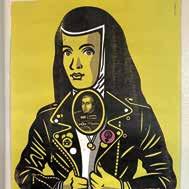


Who is MAYA PIÑA?
Cultural manager, transgender rights activist, passionate art writer, and editorial director of El BeiSMan PrESs. In Chicago, she has cofounded literary magazines such as Fe de erratas, zorros y erizos, Tropel, contratiempo, and El BeiSMan. com. Co-author and co-editor of several books.

Profiles: Karla Wong
A NEW WAY DOING POLITICS AND SEEKING EQUITY: THE ROLE OF





the consul herself, Ambassador Reyna Torres Mendivil.
Excited and grateful, she shares: “In the end, it was in Chicago where we could overcome one of our biggest obstacles and be treated as we felt, as who we are, and as how we name ourselves. We finally achieved justice through the Mexican consulates. We were given new documents, including birth certificates, passports, and other official IDs, with our name and gender.”
Karla has a clear commitment to the community to expand networks, and she took us to meet Maya Piña, who describes herself as: “Multifunctional, writer, graphic designer, cultural manager, activist for the transgender community, and passionate for art.” She came to Chicago in 1998 from Tequisquiapan, in the state of Querétaro, believing she would return to Mexico: “I came here and didn’t stay just for two years. The years kept multiplying; I didn’t go back to marry my Chencha, and I didn’t save any money either. Thirty-something years later, I’m still here,” she tells us with pride and a hint of yearning.
To arrive in Chicago in those years when the IRCA Immigration Act and the famous amnesty had just been passed complicated the immigration status of many people: “I arrived, and it was a culture shock. It was not the United States that I saw on TV; it was a ghetto, a battle zone here in Pilsen. It’s changed with time, for better and for worse. The neighborhood has transformed from what it was like back then.”
Wong And Maya Piña
WAY OF POLITICS SEEKING EQUITY: WOMEN
is KARLA WONG?
This cultural manager who belongs to the ‘92 generation, in addition to having founded, together with other people, the literary group Un lugar sin límites and magazine Fe de erratas, today is in charge of magazine El Beisman, the publisher of the same name and the Spanish book fair in Chicago. She says that the main challenges for the Latino community are summarized as: “Lack of access to good education, good housing, and bilingual programs offered by the city.”
When Maya talks —passionate and knowledgeable about the historical processes of the city of Chicago— she goes back and forth on the events that have left a mark on the city, accompanied by literary references. Now that she’s undergoing gender transition, she shares with us: “How do I begin to see the world once I accept my identity? This was a huge turn. As I accept my gender identity, I think of the books that comprised my library; it wasn’t like this. Only four female writers. There’s a huge gap here, and that was how my generation was educated. So, I started reading female authors.”
Right now, she wants to continue with the organization of Pilsen Fest and Pilsen Gourmet, as well as advising community organizations and working with restaurants, generating cultural ties with Mexico, which have faced more complicated times. Today she acknowledges the support provided by the consulate, however, she considers that there’s still a lot to be done and states: “In Mexico, there’s no interest in what we do here, or it’s considered low quality. They don’t acknowledge it; they don’t know that there are great painters and an incredible literary production. We grew tired of waiting for validation. Octavio Paz, Carlos Fuentes, Elena Poniatowska, Eduardo Galeano were brought in. Still, they came, did their thing, and left. I had dinner with Octavio, so what? What is needed are exchanges.”
We ignore the details of their transition as trans women. Although their professional paths are significant, we also know that for Karla and Maya, as for many trans women, what matters is who they currently are as the result of a process that hasn’t been easy. However, they have reached a point where they find fulfillment in their identity and their contributions to their communities.

FOR A SAFE, FULL OF RIGHTS MEXICAN LGBTQIA+ COMMUNITY ABROAD
THE UNITED NATIONS —THROUGH A GROUP OF FORTY HUMAN RIGHTS EXPERTS— ISSUED A JOINT STATEMENT IN 2022, REPORTING THE VULNERABILITY OF THE LGBTQIA+ COMMUNITY, CLAIMING THIS POPULATION SEGMENT STANDS OUT AMONG THE MOST VULNERABLE AND MARGINALIZED AMONG THE 84 MILLION DISPLACED INDIVIDUALS WORLDWIDE
“THE STRUCTURAL VULNERABILITIES THAT LGBT PERSONS FACE ARE INTENSIFIED BY THEIR SITUATION AS MIGRANTS, ASYLUM SEEKERS, REFUGEES OR INTERNALLY DISPLACED PERSONS.” UN ALSO CALLED ON ALL GOVERNMENTS TO PROTECT AND TREAT THEM WITH DIGNITY
BY ANGÉLICA SIMÓN UGALDE ILUSTRATION: ALEJANDRO OYERVIDES
The Mexican LGBTQIA+ community abroad is no stranger to such vulnerability. The Foreign Affairs Ministry has implemented different actions to promote an agenda based on diversity and inclusion that will contribute towards fulfilling their human rights.
An example of this is how Mexico’s consular network abroad is defined as Zona Segura [Safe Space], which means consulates are discrimination-free spaces that Mexicans can turn to if they become victims of homophobia or violence due to gender-related reasons, where inclusion-based services are provided to them regardless of their religion, socio-economic status, ethnic origin, sexual preference or gender identity, among other factors.
that people’s To only will process gender or
2 PASSPORTS that gender identity. that must be submitted one are the same required for an
3
MARRIAGE CERTIFICATES for all Mexican people, regard less of their sexual orientation.
4 NON-BINARY PASSPORTS, in which the gender box can be crossed out.
5 ITS
(Health Windows) information on to receive hormone or therapy, known zation in di erent
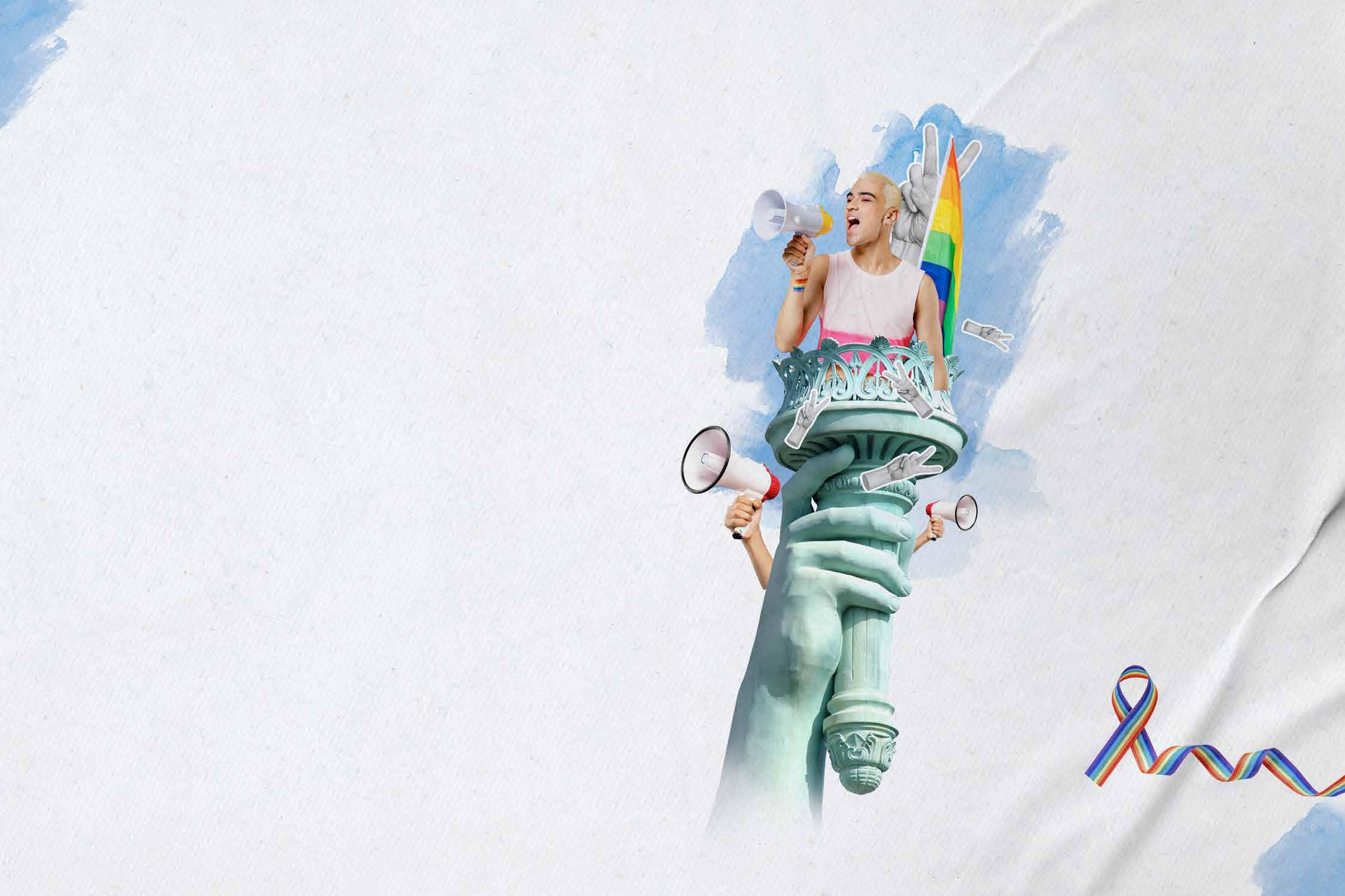
BIRTH CERTIFICATES that acknowledge people’s gender identity. apply for one, people only need to express the will to complete the process and declare their gender identity, verbally in writing.
that acknowledge identity. The documents submitted to issue same as those ordinary passport.
regardwhich
ACCORDING TO THE ADULT LGBT POPULATION STUDY IN THE UNITED STATES, PUBLISHED IN DECEMBER 2023 BY THE WILLIAMS INSTITUTE, WHICH CARRIES OUT INDEPENDENT RESEARCH ON LAWS AND PUBLIC POLICIES RELATED TO SEXUAL ORIENTATION AND GENDER IDENTITY IN THE U.S., BISEXUAL T INCLUDES TRANSGENDER PEOPLE
VENTANILLAS DE SALUD Windows) o er where and how hormone treatment known as hormonierent countries.
EVOLUTION OF THE MEXICAN REGULATION ON ISSUES CONCERNING EQUALIAND RIGHTS, APPLICABLE TO THE CONSULAR NETWORK ABROAD

REPRESENTS INTERSEXUAL PEOPLE A INDICATES ASEXUAL PEOPLE +
ENCOMPASSES GROUPS NOT REPRESENTED IN THE ABOVE LETTERS
Federal District was same-sex marriage. acknowledging the documents for was issued.

•Guidelines
•The Foreign A airs Ministry launched the Zona Segura preventive protection campaign, which defines consulates as discrimination-free spaces.
BIRTH CERTIFICATES:
938 birth certificates with gender identity recognition have been issued
5 OF THEM WERE ISSUED FOR MINORS OF THE APPLICATIONS HAVE BEEN SERVICED BY THE MEXICAN CONSULAR NETWORK IN THE UNITED STATES
MARRIAGE EQUALITY: in november 2018, the first Same-Sex Marriage took place at the Consulate of Mexico in New York to comply with the ruling made by the jurisdictional authority in a writ of amparo lawsuit.
FROM JUNE 2019 TO MAY 2024, CONSULAR OFFICES HAVE ISSUED
37 MARRIAGE CERTIFICATES FOR SAME-SEX COUPLES.
ACCORDING TO THE 2021 NATIONAL SURVEY ON SEXUAL AND GENDER DIVERSITY (ENDISEG), CARRIED OUT BY THE NATIONAL INSTITUTE OF STATISTICS AND GEOGRAPHY (INEGI)
(5.1% OF THE POPULATION) IN MEXICO IDENTIFY THEMSELVES WITHIN ONE OF THE LGBTI+ SEXUAL AND GENDER ORIENTATIONS.

2019
•Same-sex marriage is allowed in all Mexican consulates abroad.
2022
•Since January 18, 2022, Mexico’s consular o ces abroad have been authorized to issue birth certificates acknowledging gender identity.
2023
•Mexico joins the list of 16 countries that issue passports, which o er the option of not identifying oneself with the binary gender.
“THE MOLAA AND BETSABEÉ ROMERO AT THE VENICE BIENNALE -THE WORLD’S MOST
PRESTIGIOUS CULTURAL EVENTIS SOMETHING TO BE GREATLY
CELEBRATED”
The breakthrough these women have made in the art world through their presence as Latin American women in spaces that are not the usual reinforces that it is women’s time.
BY ALEJANDRA ICELA MARTÍNEZ RODRÍGUEZ PHOTO: COURTESY OF THE ARTIST
Betsabeé Romero, curated by Gabriela Urtiaga at Venice, Bevilacqua La Masa Foundation San Marco Square from April 20thSeptember 1st, 2024
As one goes from L.A. to Long Beach to the Museum of Latin American Art (MOLAA)—a museum that seems to be just any other museum at first sight—you realize that it’s one of a kind. That is both because of the people at its front and the artists and works exhibited there, which respond to the MOLAA’s primary mission of promoting, collecting, and exhibiting modern and contemporary Latino and Latin American art.
Her work has specialized in issues such as migration, miscegenation, and mobility, through the reimagination of symbols and daily rituals of the global consumer culture.
Visiting in May and being welcomed by the Vice President of Content, Innovation & Outreach, Solimar Salas, as well as by the Chief Curator, Gabriela Urtiaga —two people Betsabeé Romero had already talked extensively about (c.f. No. 3 Heraldo USA)—, and thanks to whom you are here to talk about the joint process to get to the 60th edition of the Venice Biennale International Art Exhibition, makes it all click perfectly.
When one speaks with Gabriela, aside from her joyful Argentine accent, you can appreciate a strong passion for the duty she’s been performing at MOLAA since 2019, which she’s nurtured throughout her years of experience as a curator in Latin America, as well as in Europe, working alongside important international artists, and as a consultant, a speaker and a jury member at prestigious art fairs.
She has carried out numerous curatorships and developed projects in collaboration with international institutions worldwide.
Throughout her career, she has worked with prominent international artists such as Jean Paul Gaultier, Alexandre
She has been a consultant, speaker, and jury member for leading art fairs such as Art Basel Cities Buenos Aires, Los Angeles and at and ArtParis in France.


The endless spiral
Betsabeé Romero
Argentinian art historian and curator. Since 2019, she is the Chief Curator at the Museum of Latin American Art (MOLAA) in Long Beach, CA
Arrechea, among others.
Advisor committee and nominator for Smithsonian Annual Conference and Kyoto Prize for Art and Philosophy.


● BETSABEÉ ROMERO (MEXICO, 1963)
● The Shadow of the House Was Also Broken, 2024
● Variable dimensions
● 2-color confetti folders, with silkscreen and painting on the Wall

● BETSABEÉ ROMERO (MEXICO, 1963)
● Families Divided by Sharp Borders, 2024
● Variable dimensions
● Families and signs made of tin cutouts with silkscreen and handpainting
● Courtesy of the artist, artwork commissioned by MOLAA

● BETSABEÉ ROMERO (MEXICO, 1963)
● Memories of a Moving Totem, 2024
● Variable dimensions
● GoKart wheels hand-engraved and painted with gold leaf, lace banners printed with silkscreen
● Courtesy of the artist, artwork commissioned by MOLAA


AIMR-HUSA: What was attending the 60th Venice Biennale with Betsabeé like?
GU-MOLAA: The MOLAA and Betsabeé’s presence at the Venice Biennale is to be greatly celebrated. Being part of the program of the world’s most prestigious art and cultural event fills our hearts with pride.
The task is complex because you must apply, submit a project, and create a narrative that relates to the Biennale’s theme, which on this occasion is Foreigners Everywhere. Also, this is the first time the Biennale’s art director is Latin American: Adriano Pedroza, a Brazilian artist and curator. For us, for the MOLAA —the only museum specializing in Latino and Latin American art in the United States—to say: “We are present at the Biennale together with Betsabeé Romero” represented a significant, historic moment. Only thirty institutions from all over the world were selected, two of them from the United States, and one of them was the MOLAA with Betsabeé Romero’s work.
AIMR-HUSA: What does the e xhibition consist of?
GU-MOLAA: This extraordinary exhibition, The Endless Spiral, in the middle of the San Marco Square, features six large sections in which Betsabeé, based on her incredible creation and body of work, reflects on issues related to migration, the idea of gender, the subject of borders, the theme of representation, specially commissioned to be presented for the first time in Venice.
AIMR-HUSA: What was it like for you all?
GA-MOLAA: For the museum and for the whole team working on that project, it was a grand celebration; it was a joy. Betsabeé was there, and, at the same time, together with Betsabeé and the museum, all Latin American artists were represented. It seems to me that it’s a matter of grand celebration for the whole region, for the artists who are a part of the MOLAA’s collection, but also for all those artists who, in one way or another, collaborate and are a part of the MOLAA through their exhibitions here at the museum, but also through the different educational programs that we offer. Also, for the audience, a growing audience. That is, the MOLAA is present here in the United States, with a very solid audience from Latin America, and now it has broadened its reach in Europe by exhibiting Betsabeé’s work in Venice.
AIMR-HUSA: How did you pick Betsabeé’s works out of all her production?
GA-MOLAA: Working with an artist like Betsabeé, who has been producing nonstop for many years, was both hard and easy. Betsabeé can show her works all over the world; her pieces are part of different collections, and she’s included in MOLAA’s collection. It was the artist and curator’s complicity and long-term work, knowing we would exhibit her work to a very diverse audience from all over the world.
Working on those subjects was truly interesting and enriching. It generated profound ideas around themes that Betsabeé usually imprints in her artwork, such as migration, mobility, mirroring, and identity.
AIMR-HUSA: What’s next?
GA-MOLAA: Once our stay in Venice ends, on September 1, 2024, the exhibition will be coming here, to the MOLAA, in 2025, for all our visitors to be able to continue to discover Betsabeé’s work, and for them to be able to witness the great project we’ve shown at the Venice Biennale. After that, we’ll hold an exhibition supported by the Getty Foundation focused on the intersection of art, science, and technology in Latin America, comprised of the works of twenty artists from Mexico, Peru, Chile, Argentina, and Brazil, and many emerging artists, many young artists, for whom the MOLAA is the place where they can show their work at a museum for the first time.
“LA COBRA” RUIZ, STRENGTH AND EXPERIENCE IN BALANCE
Adelaida Ruiz holds the World Boxing Council super flyweight title; she’s aiming for more.
ADELAIDA RUIZ
CHAMPION

We do the same things, we put in the same effort, we bleed the same, we sweat the same... I feel women put much more of their heart into it. You don’t have to be chasing a woman, reminding her she needs to wake up and go running or training. We already know what we must do.”

BY DANIEL BENET
Adelaida “La Cobra” Ruiz was born in Los Angeles, California in 1988. She is the World Boxing Council champion in the super flyweight category. Being a woman in the world of boxing comes with additional challenges, which she has boldly overcome to earn one of the most coveted belts in the sport. Moreover, this Mexican American champion has a migrant family history. The Mexican roots of this world-class boxer run deep. Her father, and current trainer, was born in Mascota, in the state of Jalisco in Mexico, who arrived in the United States in 1977. Although Adelaida started boxing at the age of twelve, it wasn’t an unbroken and direct path to the championship. Later in her life, she had to take a break from her sports career when she became a mother. She acknowledges that she didn’t have
PHOTO: SPECIAL
” KNEW
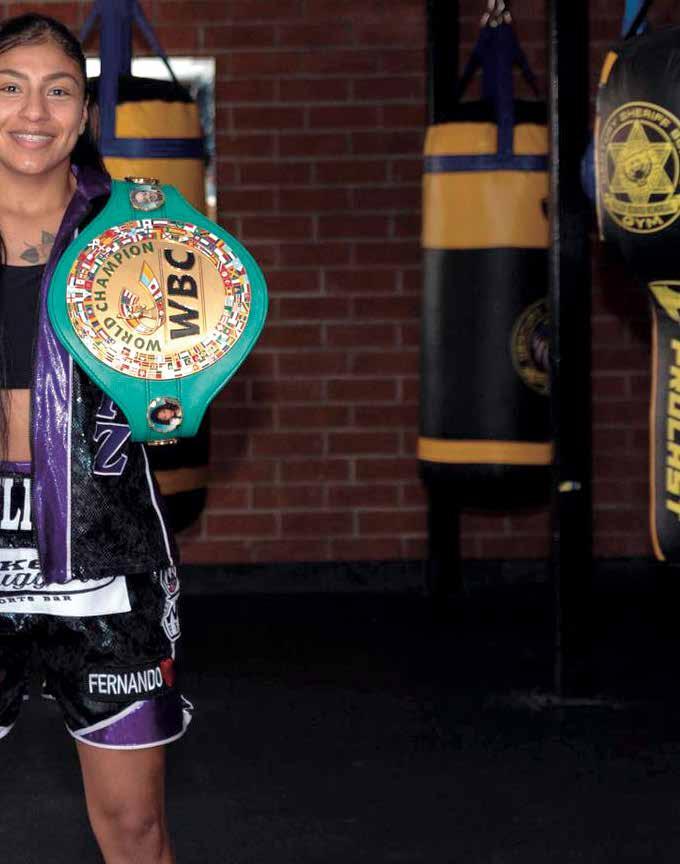
the necessary support to continue boxing while also providing for her family, so she decided to be a full-time mother, which also involved working to sustain her household. It was difficult for her to return to training and competing, but she managed it, and now boxing is one of the many responsibilities she balances in her life.
This is why she began her professional career at an age that might be considered late for most in this sport. She endured many comments about her age being a limitation to advance in the world of boxing, but with focus and determination, she has reached the pinnacle that many only envision from afar. When asked how she feels about continuing to move forward at her age, she responds with confidence that she feels stronger and smarter in boxing. Experience is fundamental. Maturity has made her understand the importance of discipline in her life, both inside and outside the ring.
“La Cobra” is always active. Preparation for her matches begins months before they take place. She
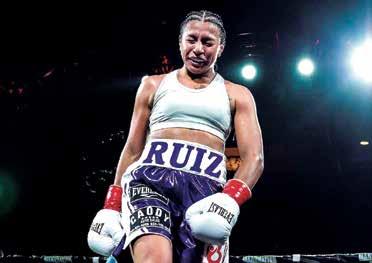
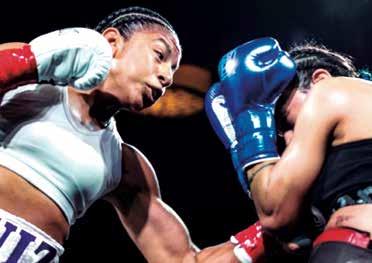
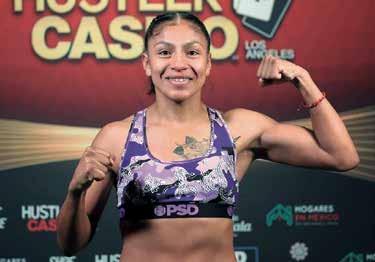
never stops practice, but when a fight is close, she more frequently incorporates sparring into her sessions, along with running and daily training. Her routine starts at four in the morning. Adelaida understands that resting is part of this preparation, but this doesn’t mean she can do it whenever she chooses to, rest for the day comes once she’s done with her other responsibilities, such as feeding her kids dinner, usually late at night.
She sees many differences between women and men in the world of boxing. Among them is the large gender pay gap between women and men who devote their lives to this discipline. Although she acknowledges that happens in other sports as well, promoters don’t give the same opportunities to female boxers as they do to men, and they don’t invest in them equally.
Regarding her vision for the future for young women who take on this path, she pictures better opportunities for them, fighting in large venues with major promoters. She also hopes that the pay will be
better for women who dedicate their lives to boxing, as sometimes managers aren’t even willing to pay them for their fights, using expenses as an excuse to cut them off. She notes that currently; to reach great venues and good pay, men and women are not required to demonstrate their abilities to the same extent, as more is always demanded of women.
“A woman has to prove and show that she can do what a man can do,” says “La Cobra.”
Her first coach gave her the nickname “La Cobra” due to the speed of her attacks and lethal punches. She had a childhood full of love, which she remembers fondly. Hers being a large family, her father had to work two to three shifts a day to support them, leaving him with little time to spend with his family. They struggled, says Adelaida, but they were always full of love.
“I was very happy because our parents filled us with lots and lots of love,” Adelaida recalls.
Her Mexican heritage was always present. In December, for instance, they had the tradition of posadas, which was not very usual in the United States in those years. They carried out processions with heavy figures of the Virgin Mary and Joseph, surrounded by candles and walking through the streets of California. Such traditions were different from those of children her age in the place where she grew up. Additionally, her first language was Spanish, so she had to take classes to learn English and catch up with her activities. She holds these memories very dear, and they influence her way of facing life.
The Mexican American community has grown significantly in the area where Adelaida was raised. Mexican culture has reached the state of California and continues to spread.
“It’s very beautiful because our traditions keep growing, and we don’t forget them,” says Adelaida proudly.
When she started boxing at the age of twelve, it wasn’t common for girls her age to practice this sport; she was embarrassed to admit she did. It wasn’t until she turned fifteen or sixteen years old that she started saying she practiced this discipline. “My dad always put the gloves on us at home, but it’s not something I wanted to do,” remembers the boxer.
Adelaida grew up playing in the gym. She didn’t think she would reach the level she has achieved in this sport. When she was little, she only played and watched her two brothers train. When she turned twelve and her sister started boxing, she followed the family’s tradition.
Her favorite fighters are Manny “PacMan” Pacquiao for his style, as well as Floyd “Money” Mayweather Jr. Current boxers she admires are Saúl “Canelo” Álvarez and Gervonta “Tank” Davis.
It was sparring in the ring that made her fall in love with boxing. That is, the adrenaline of the fight. What “La Cobra” feels inside the ring is a big part of why she loves this sport. It took her many years to reach the level of discipline she currently has. Discipline is a fundamental tool for development, she reflects. There are many occasions when, for some reason, motivation is lacking, and it is with discipline that one keeps moving forward. This lesson took her a long time to learn, but now it is part of the core of how she trains and fights.
Adelaida says, “You can be very good in the ring, but without discipline, you go down.” Although work also takes up part of her time and energy, she is grateful to have this income and enjoys what she does. She works in insurance management with medical clinics, surrounded by health experts. She is backed by the community she works with and is often congratulated by the doctors and supported by her superiors to go training and assist to her matches. They even attend her fights to cheer her on.
“La Cobra” has no intention of slowing down. She plans to have between three and four fights a year. She hopes to get her next title this year. Time is the axis on which she has balanced being a mother, working, and moving forward with a successful boxing career.
● LA COBRA RUIZ has a record of 16 fights, with 15 wins (8 by KO), 0 losses, and 1 technical draw.
● WATCHING LA COBRA in action makes it clear why she earned her nickname. The speed and lethality of her punches are astonishing.
● TIME HAS GIVEN Adelaida perspective on the importance of discipline. Now she feels stronger and more experienced than ever.
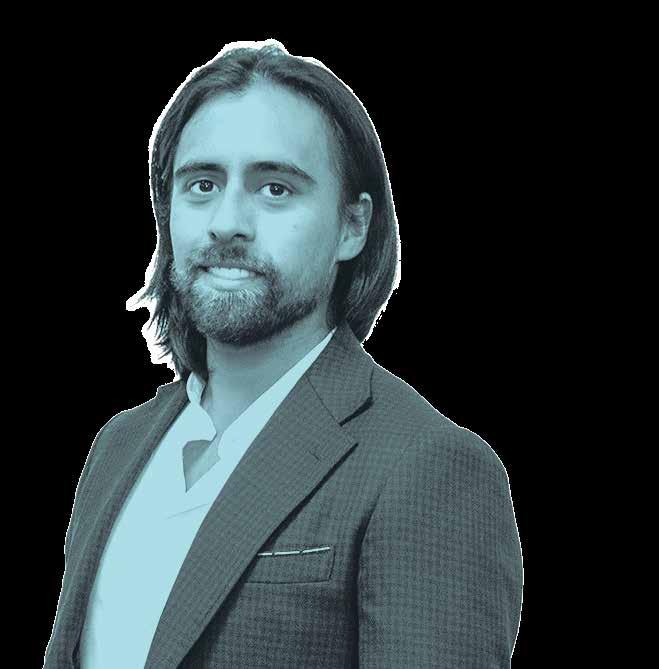
Miguel A. Fuentes Carreño
COORDINATOR

Double borders: Why U.S. Immigration doesn’t see
LGBTIQ+ Latine Immigrants
THIS YEAR HAS COME WITH SIGNIFICANT CHANGES IN THE U.S. IMMIGRATION POLICY AND LEGAL LANDSCAPE, BY CREATING DOUBLE BORDERS TO LGBTIQ+ IMMIGRANTS, PARTICULARLY THOSE FROM LATIN AMERICA. THEY FACE NOT JUST A PHYSICAL BORDER THAT IS GETTING TIGTHER, BUT ALSO AN INVISIBLE BORDER WITHIN THE SYSTEM ITSELF. PRESIDENT BIDEN ENFORCED NEW RESTRICTIONS TO ASYLUM SEEKERS IN THE SOUTHERN BORDER, TIGHTENING THE REQUIREMENTS TO OBTAIN THE STATUS.
@MIGUELFUCA RESEARCH
AT YAAJ MÉXICO
Afew days later, he announced a new policy shielding undocumented spouses of U.S. citizens from being deported. However, a few days later, the Supreme Court ruled that U.S. citizens have no constitutional interest in their non-citizen spouses to enter the country. These changes come with diverging messages: the first policy tells a story of an uncertain future for those who are coming; and the clash between the second and the Supreme Court’s ruling brings hope for some of those who have arrived, but a dangerous setback for same-sex couples. In these debates we are missing LGBTIQ+ immigrants, and particularly those coming from Mexico. People are coming from farther and farther to reach that southern border. However, for those in the LGBTIQ+ community, waiting for a better life isn’t an option. They are forced to undertake increasingly long and dangerous journeys to reach the southern border, while making themselves a target due to their sexual orientation, gender identity or expression, and variations in sex characteristics.
To have a sense of the magnitude of these policy and legal changes
on sexual and gender minorities, particularly those coming from Latin America, let us first look at some numbers. According to a 2021 report by the Williams Institute at UCLA, out of the estimated 1,274,500 LGBTIQ+ foreign-born adults in the U.S., 289,700 (22.7%) are undocumented. Even more, three quarters (75.7%) are racially identified as Latines, 12 out of the 20 identified countries they were coming from were Latin American, and more than half of all migrants were born in Mexico.
Mexico is a migratory corridor for most of the continent under the U.S. southern border, and even for people coming from overseas. The new restrictions on asylum applications create a new barrier to an already tightened process, which does not include any specifics on how to treat LGBTIQ+ asylum seekers. Activists continue to highlight how the U.S. borders are now pushed down all the way to Darian Gap, where the U.S. government is working with the Panamanian government to surveil and deport people even from Panama.
The question that lingers in the background is how many difficulties migrants, particularly LGBTIQ+, increasingly face to even reach the border: discrimination by migratory authorities and local communities; violence and abuses by cartels and organized crime; dangers of human trafficking and being victims of other crimes, all due to their combined vulnerabilities of migratory status, racialization, and openly being LGBTIQ+. Asylum seekers do not want to remain on the Mexican northern border. To take action, LGBTIQ+ migrants, both Mexican and international, are creating new grassroot movements —like “Rompiendo Fronteras” in the border city of Matamoros— that build a safe community of migrants, and puts pressure to border authorities to guarantee a safe pathway through new entry points —like Brownsville, Texas.
/ 06 / 30 / 2024


Many shelters along the way in Mexico, up to the southern border of the U.S., have religious affiliations. Any recognition of their sexual orientation, gender identity or expression, or variations in sex characteristics, represents a risk to be unwelcomed. Being without a shelter means these migrants do not have stable access to wifi to use the CBP One app. Once at the border, and if they manage to use the app, LGBTIQ+ asylum seekers have to face the border patrol agents as the person who chooses if they will even be allowed to enter the physical office to apply for asylum. Based on fieldwork, activists confirm same-sex partners, if detained, are usually separated, and trans people are undercounted because their gender self-identification is not evenly recognized across border-states.
These new restrictions give a message of uncertainty for those fleeing scenarios of discrimination and violence that will not get better even if staying in Mexico. LGBTIQ+ Latin American immigrants, including Mexicans, will be part of a demographic phenomenon that keeps growing, with more and more LGBTIQ+ migrants identified at the U.S. southern border. At the same time, we see new pathways to asylum (like Argentina or Costa Rica) become available, although less popular.
How many difficulties migrants, particularly LGBTIQ+, increasingly face to even reach the border.
However, our biggest concern at present is how these new restrictions to apply for asylum will make the experience of trying to cross the border even more difficult. We must recall that the U.S. Customs and Border Protection Office launched in 2020 a new phone app where asylum seekers are required to schedule their appointments and any other asylum-related services. Human Rights Watch research shows that LGBTIQ+ migrants face specific challenges when using this app, as they struggle accessing a smartphone, as well as accessing wifi.
The second announcement, regarding protections to undocumented spouses to U.S. citizens, does bring a light of hope, and a breath of fresh air amid the strict immigration policies that have been taking place in recent years. However, the ruling by the Supreme Court that there was no fundamental right to U.S. citizens to live with their spouses if they married, poses a particular threat to same-sex couples, as Justice Sotomayor argued in her dissenting opinion. Sotomayor warned us that this is a major setback to the core principle of Obergefell v. Hodges: that citizens do have a right to marriage. She argued that restrictions on who is allowed to be married in the U.S. extends beyond this decision. Because the 2015 ruling on same-sex marriage decision depends on American law for same-sex couples’ marriage validity, the newly passed ruling may force same-sex couples with one partner having a non-citizen status to relocate to countries that do not recognize their union, or even to countries who criminalize them.
The impact on LGBTIQ+ undocumented immigrants in the U.S. is particularly significant.
cumented immigrants in the U.S. is particularly significant, and even more for those in California, where the highest percentage of this population live (68,800 according to another Williams Institute study). According to the same study from the Williams Institute I mentioned earlier, around 17% of all same-sex couples in the U.S. in 2021 included a foreign-born spouse or partner. More surprisingly, when comparing same-sex versus different-sex couples, the same study finds there are more same-sex couples where one of them is a non-citizen (35% vs. 14%). Similarly, 21.8% of undocumented LGBTIQ+ Latine immigrants in California without a Green Card are married. Thus, the new executive order could bring greater benefits for some LGBTIQ+ couples with different citizenship status, but advocates already argue the current executive order gives no details on how the current administration intends to defend this program against legal challenges like the one that just came from the Supreme Court. Even more, the announcement is a factsheet, rather than an executive order or a presidential proclamation, giving it a very fragile legal gloss. While a glimmer of hope exists for some, the recent changes in the U.S. immigration system may not be so kind for most spouses of undocumented LGBTIQ+ immigrants, particularly those from Latin America. These hurdles highlight how the U.S. immigration system is not looking at the unique realities of LGBTIQ+ asylum seekers, and same-sex couples. In other words, LGBTIQ+ migrants face unique vulnerabilities that are only worsened with the current legal and policy changes in the U.S. immigration system: tightening restrictions, a more hostile legal landscape, and ongoing vulnerabilities on their journeys. As new and ongoing LGBTIQ+ grassroot movements continue to advocate for voices turned invisible by these borders, the agenda for equality demands a more inclusive vision of social justice. More data is necessary to understand the needs of these communities, to have a better and informed vote, and to bring to the center of the table those who continue to be left behind.
The impact on LGBTIQ+ undo-
Miguel A. Fuentes Carreño, PhD Miguel Fuentes is the Research Coordinator at Yaaj México. He holds a PhD in Global Studies (UCSB) and a BA in International Relations (El Colegio de México). He currently lives and works between Los Angeles and Mexico City, specializing in international LGBTIQ+ rights.

